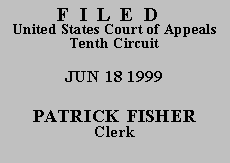

| UNITED STATES OF AMERICA,
Plaintiff-Appellee, Defendant-Appellant. |
No. 98-6372
(D.C. No. 98-CR-57-A) |
Stacy Anne Laughlin entered a guilty plea to one count of maintaining a dwelling for the purpose of manufacturing methamphetamine in violation of 21 U.S.C. § 856(a). On appeal, she contests two sentencing issues, first, that the district court erred in failing to award her a four-level reduction for a minimal role in the offense and second, that the court erred in attributing to her over 300 grams of actual methamphetamine. We affirm.
Ms. Laughlin was arrested with her co-defendant, Paul Harris, in an Oklahoma City motel room where Mr. Harris ran a methamphetamine lab. A second lab was found inside another motel room registered under their names. Ms. Laughlin admitted they had been living in motels for over six months. She also admitted that she helped obtain the motel rooms, knew about the manufacturing of methamphetamine, helped clean up after cooks, and was present during the purchasing of supplies and the sales of drugs. After considering Ms. Laughlin's lesser role in the offense, the district court awarded her a two-level downward adjustment as a minor participant rather than a four-level downward adjustment as a minimal participant.
Ms. Laughlin contends she was a minimal participant entitled to a four-level reduction because she played such a limited role in the enterprise and did not distribute, sell or profit from the methamphetamine except that she herself was an addict. We review a district court's findings concerning a defendant's role in a particular offense for clear error. See United States v. Santistevan, 39 F.3d 250, 253 (10th Cir. 1994). The burden is on the defendant to establish the propriety of an offense level reduction. See id. We also give due deference to the court's application of the Sentencing Guidelines. See United States v. Hankins, 127 F.3d 932, 934 (10th Cir. 1997). The Sentencing Guidelines, USSG § 3B1.2 application notes, warns that a reduction for minimal participant is to be used "infrequently," USSG § 3B1.2 comment. n.2, and applies in situations where the defendant "lack[ed] knowledge or understanding of the scope and structure of the enterprise and of the activities of others," id. at comment. n.1.
In the instant case, it is undisputed that Ms. Laughlin had knowledge of the criminal enterprise and of Mr. Harris' activities, and that she assisted in renting the rooms and cleaning up. Since Ms. Laughlin offered nothing to challenge the evidence that she was more than a minimal participant, she failed to meet her burden of persuasion. We therefore conclude the district court properly determined she was not a minimal participant and was not entitled to the corresponding four-level reduction in her offense level.
Ms. Laughlin next contends the district court erred in attributing more than 300 grams of methamphetamine to her. The district court's determination of the drug quantity attributable to Ms. Laughlin is a factual finding that we review for clear error. See United States v. Arias-Santos, 39 F.3d 1070, 1078 (10th Cir.1994). Drug estimates based on extrapolation from a quantity of a precursor chemical are permitted. See United States v. Havens, 910 F.2d 703, 704-05 (10th Cir. 1990).
The disputed amount of drugs turns specifically on conflicting evidence over the amount that could be produced from two cases of pseudoephedrine that Mr. Harris admitted he had purchased to use in approximately ten methamphetamine cooks. Mr. Harris stated that he produced a total of 121 grams. On the other hand, Sergeant Long, an experienced narcotics officer, testified based on his training that two cases of pseudoephedrine would conservatively make 894 grams. Since the district court is in the best position to assess the credibility of the evidence, see Hankins, 127 F.3d at 934, we conclude there was no error where the court chose to rely on Sergeant Long's testimony to determine that the estimated attributable drug quantity was more than the sentencing threshold amount of 300 grams.
We AFFIRM the district court.
ENTERED FOR THE COURT
Stephanie K. Seymour
Chief Judge
*.This order and judgment is not binding precedent, except under the doctrines of law of the case, res judicata, or collateral estoppel. The court generally disfavors the citation of orders and judgments; nevertheless, an order and judgment may be cited under the terms and conditions of 10th Cir. R. 36.3.